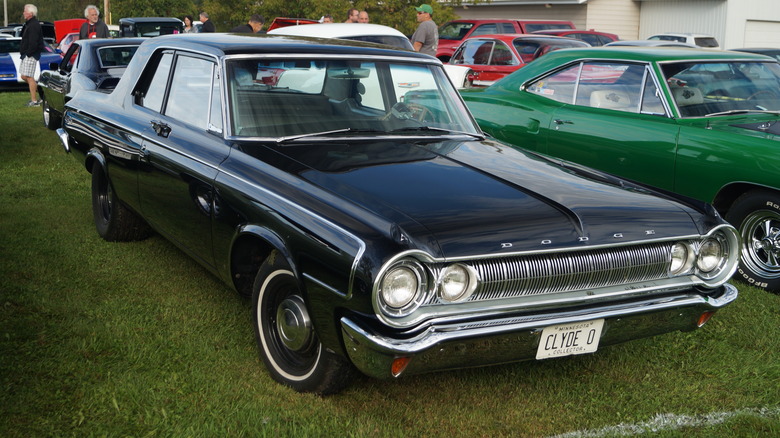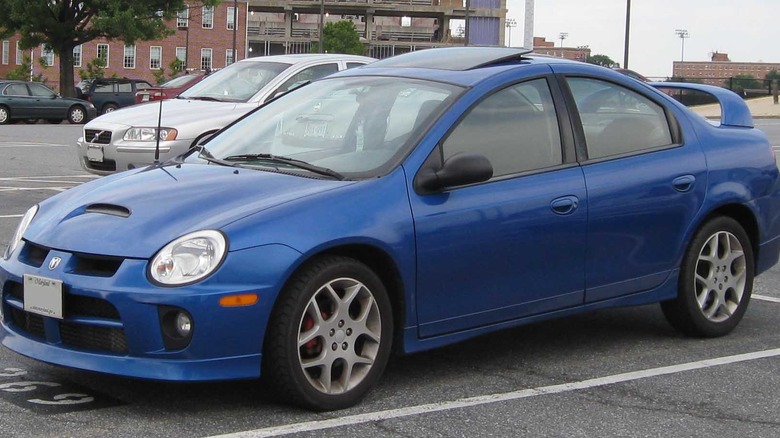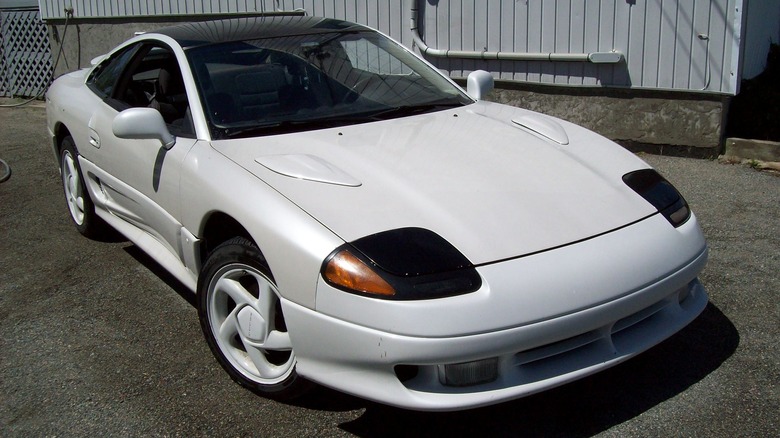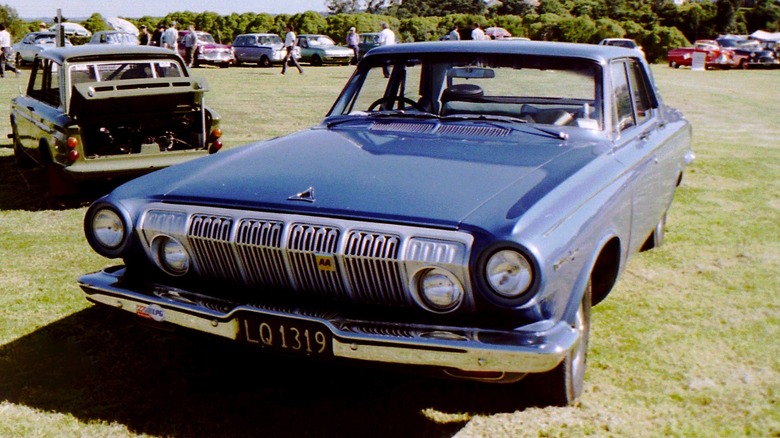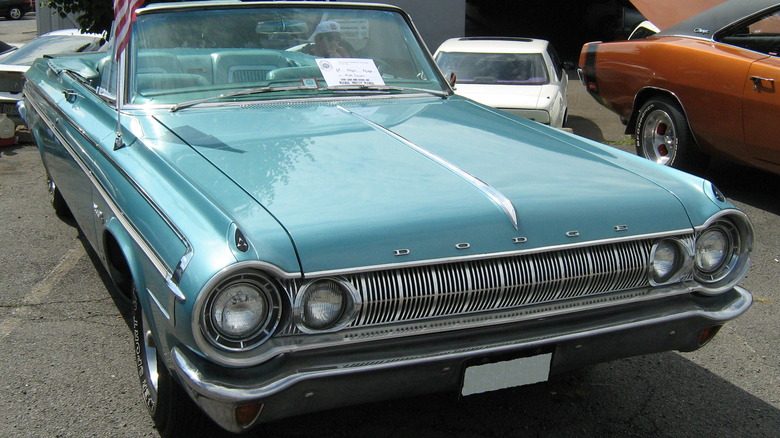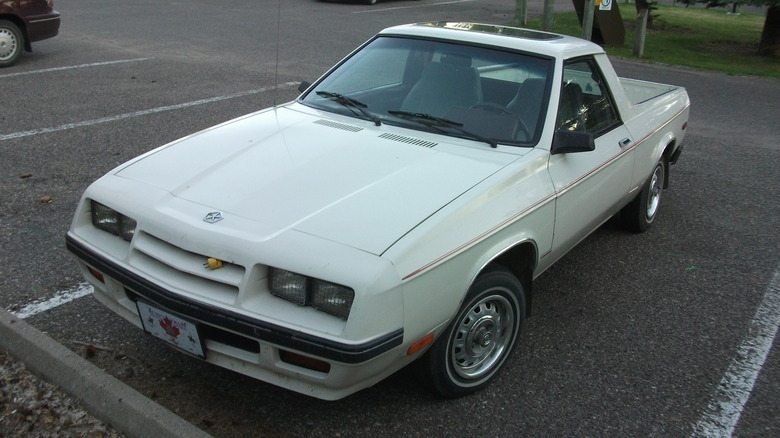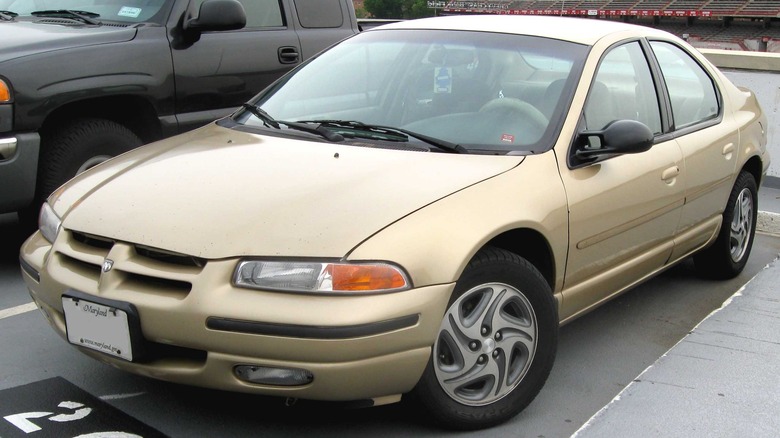6 Underrated Dodge Models That Deserve A Spot In Your Garage
Dodge has created someone of the most successful models ever sold in the U.S. Of course, almost no conversation about the company's impact can begin without discussing its proliferation of muscle cars back in the 1960s and '70s, including models like the Dodge Dart, Coronet, and Charger. As the years progressed, Dodge also ushered in the era of Ram trucks, which became so popular that they eventually spun off to become their own brand. Dodge has made a few duds in its time, such as the Dodge Caliber in the mid-2000s, but its track record for automotive icons is impressive.
Because Dodge has been around so long and has made such a wide variety of vehicles, that also means many of its productions have naturally fallen by the wayside, occasionally becoming grains in the sands of time. However, just because a car isn't as popular as the Dodge Charger doesn't mean it isn't worth remembering. There are plenty of vehicles in Dodge's history that have slipped through the cracks that are worth another look. From the dozens of cars Dodge has produced, here are six that deserve a better legacy.
[Featured image by Greg Gjerdingen via Wikimedia Commons | Cropped and scaled | CC BY 2.0]
Dodge Neon SRT-4
In general, the more power you want for your vehicle, the more money you have to put down to get that power. Performance vehicles are such an enticing prospect for so many car buyers, as everyone to some degree gets caught up in the allure of pushing the gas pedal to the floor and zooming down the street. Well, Dodge had a very short-term offering to satisfy this desire with a vehicle that could marry affordability with power. Running from 2003 to 2005, this model was the Dodge Neon SRT-4.
The Neon had been around since the mid-1990s, but in 2003, Dodge opted to give the vehicle a turbocharged 2.4-liter engine, featuring the company's Street and Racing Technology (SRT) division label. Suddenly, you were treated to a car that could generate 215 horsepower and 245 pound-feet of torque. For comparison, the standard Neon from 2003 had an output of just 132 horsepower and 130 pound-feet of torque. The SRT-4 took things to a whole new ballgame with power.
What makes it even more exciting, though, is the price. The base cost of a Neon SRT-4 was just $19,995 (about $34,140 adjusted for inflation). While it's not the peak of Dodge performance, getting that kind of power without breaking the bank should be celebrated.
Dodge Stealth
Along with high performance vehicles, sports cars also have the tendency to be pretty hard on the wallet. After all, these types of cars are coveted by so many automotive fans for their sleek appearance that the idea of being seen driving one is just as — if not more — exciting than actually driving it. Over the years, several car companies have tried finding that balance between sports car sexiness and moderate affordability for consumers. That includes Dodge, which introduced the Dodge Stealth for the 1991 model year.
This vehicle was actually a rebadged edition of the Mitsubishi 3000GT, which was being sold simultaneously in North America. The two-door coupé was outfitted with a 3-liter V6 that could be altered with turbochargers the further up the performance package ladder you decided to go. The top-shelf model was the Dodge Stealth R/T Turbo, which increased those numbers to a rather impressive 300 horsepower and 307 pount-feet of torque.
In terms of pricing, you were looking at a starting price of around $16,600 back in 1991. The jump up to that R/T Turbo version isn't as friendly at the Neon SRT-4, with a starting price of $29,595, but the Stealth did have a mid-tier ES option that could generate 222 horsepower for about $18,400. This hidden gem being called the Stealth couldn't be more appropriate.
[Featured image by Jeffbond12 via Wikimedia Commons | Cropped and scaled | CC BY-SA 3.0]
Dodge 330
Now let's jump back to that point in history where Dodge was creating a number of its most iconic vehicles. The 1960s saw the company diving headfirst into the muscle car arena, creating cars that were beautiful to look at. Plus, you could put hulking engines underneath the hood of them, too. Models like the Coronet, Challenger, and Charger get all the love nowadays, but Dodge had plenty of underrated muscle cars that deserve more praise than modern eyes give them. One of those vehicles was the Dodge 330.
The lifespan of the Dodge 330 was very short, lasting from just 1962 to 1964 in the United States with an extra year tacked on at the end in Canada. Like the others on this list, Dodge's aim was to make this an affordable option for a type of car that typically would cost the customer quite a bit of cash.
This was a full-size sedan — though station wagon versions were also available — that either came with a standard 3.7-liter I6 engine or one of several different V8s, going all the way up to a massive 7-liter V8 for the Max Wedge trim that could generate 425 horsepower. At the end of its run, Dodge basically folded this model and the 440 into the Dodge Polara for streamlining, but the 330 was a good mix of power and affordability.
[Featured image by GPS 56 via Wikimedia Commons | Cropped and scaled | CC BY 2.0]
Dodge Polara
Speaking of the Polara, that is the next Dodge on this list. Unlike the last three vehicles, the Polara actually had a fairly healthy life on the market. It was introduced for the 1960 model year and managed to last all the way through 1973. Part of the reason why it was able to have that kind of staying power was that Dodge would frequently change where in the pecking order it would be placed. The Polara began as a top of the line full-size model in terms of luxury, and it came equipped with an impressive 6.3-liter V8 as its standard engine.
After a couple of years, Dodge redesigned its entire fleet with smaller frames, downgrading the full-size Polara to more of a mid-size vehicle. Now called the Polara 500, that 6.3-liter engine was reduced down to a 5.9-liter V8 instead, though that could still generate 305 horsepower and 395 pound-feet of torque. A few years after that, the Polara was put back onto its original, larger platform to once again be a full-size vehicle. It regained that 6.3-liter V8, but it was no longer at the top of the company's list in terms of luxury. In fact, now Dodge was using its affordability as a key marketing factor.
The Polara would linger around through 1973 without truly joining the ranks of the Dart or the Charger, which Dodge revived relatively recently. Although the Polara hasn't been resurrected, that doesn't mean it wasn't a worthwhile car.
Dodge Rampage
There is a type of vehicle that really does not get made anymore, basically dying out in the mid to late-1980s, called a coupé utility. Essentially, these are standard passenger cars that also have a pickup truck bed on their rears. Back in the day, many of the major companies had their own coupé utility vehicles, such as the Ford Ranchero and Chevrolet El Camino. In the case of Dodge, it was the Dodge Rampage.
Introduced for the 1982 model year, the Rampage only managed to last through 1984, making it a rather late entry in the coupé utility landscape. Although its standard issue 2.2-liter I4 engine could only generate about 84 horsepower, you were able to get the best of both worlds between cars and trucks. On the one hand, the Rampage had pretty stellar fuel economy with 21 mpg in the city and 29 mpg on the highway, which you would basically never get on a regular pickup truck. However, you still had the truck bed that could carry a payload of up to 1,145 pounds.
Because the car was more than a decade late to the party, sales never really took off, and the Dodge Rampage was discontinued. The Rampage name was actually revived in 2024 for a pickup sold in South America through Ram trucks, but it's a standard pickup and not a coupé utility.
[Featured image by dave_7 via Wikimedia Commons | Cropped and scaled | CC BY 2.0]
Dodge Stratus
The last vehicle on our list is maybe one a good deal of you are familiar with. In its time, it was a vehicle that consistently sold over 100,000 units in the United States every year, so chances are you saw it on the street everywhere after it was introduced for the 1995 model year. However, chances are also strong that if you saw it, you didn't give it much thought. That vehicle would be the Dodge Stratus, which had a decently long life through 2006.
This mid-size sedan was not flashy in the slightest. Sporting a standard 2-liter I4 engine that generated 132 horsepower and 129 pound-feet of torque, it was not a powerhouse either. This was designed to be an affordable, accessible vehicle, which had a starting price around $15,000 back when it first hit the market. Despite its modesty, reviews were initially quite stellar for the Dodge Stratus, such as Car and Driver praising it for not sacrificing design in its aim for efficiency.
Over the years, Dodge would introduce a coupé iteration of the Stratus, and a number of different V6 engines would be made available alongside the standard I4s. By the mid-2000s, the Stratus had its run. But Dodge decided to replace the car by reviving the Avenger nameplate, which had been dormant since 2000, for the 2008 model year. Dodge also revived the classic Challenger name that year, too. There just was no more space for the Stratus, a solid vehicle that time has passed by.
